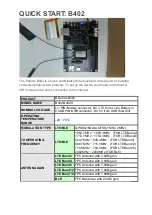
MAX 10 NEEK
53
www.terasic.com
February 4, 2016
5
5
.
.
2
2
P
P
o
o
w
w
e
e
r
r
M
M
o
o
n
n
i
i
t
t
o
o
r
r
There are three built-in power monitor (LTC2990) on the NEEK10 board to observe total of six
voltage and current buses. Each LTC2990 can monitor two sets of voltage and current rail . The six
sets correspond to the core voltage/current and I/O voltage/current of MAX 10 device and the
power rails of 5V/3.3V/1.2V/1.5V of the system. This demonstration uses these six buses to
calculate the power consumption and display the result on the two 7-segments. The voltage
measured from the sense resistor will be digitized through the power monitor and feed into the
MAX 10 device via I2C protocol. The current is calculated based on the value of the sense resistor
and the voltage measured. The power consumption of each bus can be calculated accordingly and
switched via SW[2:0] onboard.
Function Block Diagram
Figure 5-2
is the function block diagram of this demonstration. The power bus monitored are
5VCORE/2.5VCCIO/1.5VCCIO/1.2VCC/5VCC/3.3VCCIO. The sensing resistors connected
between the source and the system are 0.01
Ω
/0.01
Ω
/0.01
Ω
/0.01
Ω
/0.01
Ω
/0.01
Ω
, respectively .
When the system is powered on, there will be current floating through each bus and causing voltage
drop across the sensing resistors. The power monitor (LTC2990) will convert the voltage drop from
analog to digital and the result can be retrieved via I2C protocol. The module POWER_I2C can
read out the result of each power monitor and calculate the power consumption accordingly. The
power bus can be selected by switching SW[2:0] and the value will be displayed on the two
7-segments on the NEEK10 board. The unit is in mW
Figure 5-2 Block diagram of Power Monitor demonstration














































